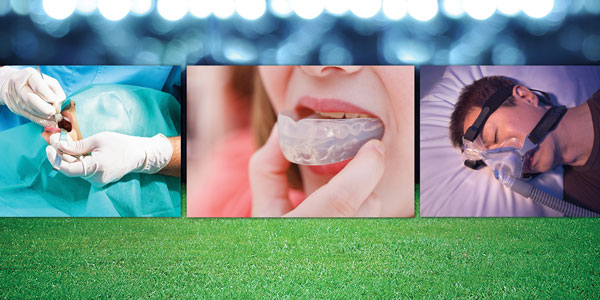by Neal Seltzer, DMD, FAGD, D.ABDSM, D.ACSDD, D.ASBD
The time-tested, leading treatment options for Obstructive Sleep Apnea have been variations of surgery, Positive Air Pressure, Oral Appliance Therapy, or any combination of the three. There have been several other valid attempts to treat OSA such as EPAP (expiratory positive air pressure), hypoglossal nerve stimulation, weight loss, and positional therapy.

All treatments must be proven to work by an efficacy study showing reduction of a patient’s AHI and ODI to a healthy level. In the cases where surgery has been performed, if efficacy is proven successful the patient is deemed “cured”. For treatments that require the cooperation of the patient using technology such as a PAP machine, an oral appliance, EPAP, or positional therapy, compliance is vital in assuring that the results are consistent.
Compliance is necessary to ensure effective treatment. CPAP machines have had the advantage of built in smart cards and modems to record and transmit data for years, enabling physicians to monitor patients’ usage. The definition of compliance use for CPAP has been “a minimum of four hours of use per night and a minimum of 21 nights in a 30-day period”. The bar has certainly been set low for CPAP compliance. This is most likely due to the difficulty so many patients have living with CPAP. Inherent issues CPAP present such as intolerance to air pressure, ill-fitting masks, noise in the bedroom, maintenance of the machine, and a myriad of side effects such as facial sores, dry mouth and airway, upper respiratory infections, and ingesting air into the stomach, to name a few.
According to recent studies, up to 83 % of patients with OSA were reported to be non-adherent to CPAP treatment within several months of initiating treatment. In addition, people forced to wear CPAP to prove compliance for work related issues have often tampered with the compliance monitoring to “fool” the machine. Some examples of this tampering include having other people wear it for them or staying awake for the four required hours while they use it and sleeping the rest of the night without it.
Non-compliance results in continued morbidity, daytime sleepiness, poor work performance, affects systemic illness, increased medical costs and increased mortality from health-related deaths, as well as traffic, transportation, and industrial accidents.
It has taken the medical world quite some time to “warm up” to the concept of Oral Appliance Therapy as a valid treatment option for Obstructive Sleep Apnea. For over two decades, the dental community has worked diligently and proven, through research and science, that oral appliances can be equal to and sometimes better than CPAP in helping patients conquer OSA Efficacy studies have shown that oral appliances do indeed work. People tell their dentists that oral appliance therapy has given them an answer where other treatments have failed.
Despite these remarkable, life changing, success stories, there has remained one hurdle to truly enabling Oral Appliance Therapy to compete with CPAP in the eyes of the medical world. That hurdle has been an inability to prove compliance like there is with CPAP therapy…until now.
It is time to level the playing field. In June of 2015, the FDA cleared select appliances to incorporate the Braebon DentiTrac microrecorder into their design. The micro recorder, approximately the size of a fingernail, is embedded into the oral appliance. It’s tiny CPU measures temperature change, time, and positional changes via a triple axis accelerometer. This data is transferred using infrared signals to a proprietary reader and then downloaded to create reports yielding the compliance information. This remarkable device enables the doctor to record: number of days used; days since first use; average daily use; average weekly, monthly and semiannual information; and positional information. Additionally, it is HIPAA compliant, has a 6-month memory and a 5-year power supply.
Probably the greatest attribute this tiny compliance monitor brings to the field is its high reliability based on sophisticated algorithms. This accuracy, along with the fact that oral appliances are custom made for an individual and cannot be worn by anyone else, ensure results that are virtually tamper proof.
The ever-growing public safety issue of undiagnosed and untreated OSA has made the highways, railways, and air travel industry a concern for all. The increased association of sleep apnea related transportation accidents has influenced the federal government and many states to instill laws mandating testing for sleep apnea. Along with pressure from insurance companies, workers who can affect the safety of the public and who test positive for sleep apnea must be treated successfully and show compliance.
Although things are progressing in the right direction, some obstacles still need to be addressed. Adding the compliance recorder adds additional lab cost and overhead expense for downloading from the recorder and generating a report. Despite the added benefit of compliance for the patient, the public, and ironically the insurance companies themselves, they have not recognized this value and there are no provisions for insurance companies to pay for this additional cost. This will come down to a business (marketing, branding, service mix) decision for the dentist. Ultimately, the patients will pay.
Until recently, CPAP was the only technology capable of proving compliance. Unfortunately, many individuals cannot tolerate CPAP. With the new laws in place, these individuals will not be able to prove compliance and therefore will not be able to legally work or meet insurance standards. However, with the advent of compliance monitoring in oral appliances using the DentiTrac, an alternative treatment option is now available. Moreover, according to Braebon, objective data gathered to date in early stage university studies confirm subjective data recorded over the last two decades showing Oral Appliances, with their high compliance rate of close to 90% over a long period of time, and an average daily use of almost 8 hours (double the standard for CPAP), are an excellent treatment option for treating OSA in general and when compliance is mandated for industry and public safety.




